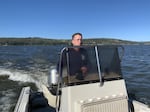
Lost River suckers congregating to spawn on Sucker Springs in Upper Klamath Lake, Oregon.
Brian Hayes / USGS
Biologist Alex Gonyaw aims his Boston Whaler up the eastern shore of Upper Klamath Lake. He’s showing off what, he says, used to be abundant habitat for juvenile fish in the lake.
“It’s a mosaic of cattails and willows and tules or bullrushes,” Gonyaw says. “The more hiding places for juvenile creatures the better they generally tend to do.”
At almost 30 miles long, Upper Klamath Lake is the home to several types of fish that live only here. Two of them are called C’waam and Koptu in the Klamath Tribes’ traditional language or, in English, the Lost River and shortnose sucker. They have a stubby face and wide lips and can live to be 50-years-old.
“They’re an endemic species,” he says. “It’s only found here, nowhere else in the universe. And due to their sort of near-extinction-level status, they are becoming something of a figurehead in the water crisis here.”
In recent years, the juvenile fish have been dying, causing the overall population to crash. Five years ago, when Gonyaw started working for the tribes, there were about 20,000 shortnose suckers in the lake. Estimates today put them at just 3,400. The Lost River sucker is disappearing at a similar rate.
Exactly why these fish are dying is unclear but biologists believe it’s because of poor water quality and habitat loss that’s impacted by low water in the lake. Those factors make their future grim.
“There’s a catastrophic event likely in the next few years,” Gonyaw says.

Klamath Tribes Senior Fish Biologist Alex Gonyaw boats across Upper Klamath Lake. Gonyaw is working to try to save the endangered C'waam and Koptu, or Lost River and shortnose suckers that live in the lake.
JPR / JPR
In this extremely dry year in the Klamath Basin, much of the debate over who gets water depends on these fish. Water flowing out of the lake has been shut off to farmers who rely on the federally managed irrigation system of canals, dams and reservoirs known as the Klamath Project. Even further down the Klamath River, threatened coho salmon are also getting the bare minimum water.
Besides being protected under the Endangered Species Act, the C’waam and Koptu are culturally important to the Klamath Tribes who say they’ve subsisted on the fish since time immemorial.
At a recent rally in Klamath Falls, Tribal Chairman Don Gentry talked about how the Klamath people prayed for the fish to return after hard winters.
“Those fish are so important. We wouldn’t be here likely without those fish that helped us survive,” Gentry said.
The declining numbers of C’waam and Koptu also illustrate a problem with the U.S. government’s treaty. In 1864 the Klamath Tribes gave up around 20 million acres of land, in exchange for the right to hunt and fish on their new reservation. Gentry says those treaty rights don’t mean much if there are no fish to catch.
“What good is a treaty if you don’t have the resources?”
The Endangered Species Act is meant to prevent species from going extinct. Gentry says it doesn’t live up to the treaty’s responsibility of providing harvestable resources.
“So we’re basically relegated to the ESA,” he says. “It’s not even working for us, but that’s the thing that we have.”
The Klamath Tribes have senior water rights. But farmers in the basin are the other group that is linked to these fish. Mark Johnson represents irrigators with the group Klamath Water Users Association.
“Ultimately, the farmers, they want all fish species to thrive because if the fish are doing well, everybody’s doing well,” he says.
For 15 years Johnson studied Lost River and shortnose suckers as a fish biologist with the US Geological Survey. One of the big frustrations from the irrigator standpoint, he says, is that water is prioritized to protect fish, but they’re still dying.
I asked Johnson, wouldn’t taking more water out of the lake be gambling with the existence of a species?
“Yeah, I mean, you are,” Johnson says, “But in terms of an extinction-level event, I don’t think that’s actually going to happen. But on that trajectory we’re on right now, basically managing the lake the same way we have for over 20 years, we haven’t moved the needle. So, something has to change.”
There are no long-term solutions for saving the native fish populations. For the first time this year, the Klamath Tribes are raising juvenile fish from eggs in a hatchery. When mature, they’ll be released into Upper Klamath Lake.
This exceptionally dry year is shining a spotlight on the Klamath Basin and how there just isn’t enough water to go around. And with current climate trends, there’s little reason to think abundant water will be available any time soon.




